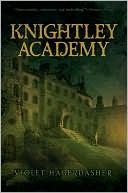 Knightley Academy, by Violet Haberdasher
Knightley Academy, by Violet Haberdasher
Rating: 4 out of 5
Henry was just a servant boy, until a twist of fate allowed him to sit an exam that would earn him a spot at Kingsley Academy for knights-in-training and the title of the first commoner to be admitted to the elite academy. When Henry arrives at the school, he quickly learns that making his way to classes and finishing his school work is the least of his worries. Someone wants Henry out of the school, and they are willing to stop at nothing to get rid of him, including attempted murder. While trying to hunt down and stop his saboteurs, Henry stumbles upon a plot for war and realizes that things are bigger than just him, and that more than his possible expulsion is at stake.
I picked up this book because I saw a comparison of it to Harry Potter. Being a huge Harry Potter fan, I decided to give it a shot. And I’m happy I did.
Like Harry Potter, Henry Grim is an orphan. And like Harry, Henry learns that he is going to a special school. Only, Henry does not have magical skills. He merely is a very smart boy. And the school is not a school of witch craft and wizardry. It is a school for future knights.
Although Knightley Academy lacks the magic element from the Harry Potter books, I think it is still magical in it’s own way.
Haberdasher has created a world based off of an alternate history. Alternate histories are always interesting because they make you think about the importance a minor change in the past could have on your current life today. They also open up a world of possibilities, much like the existence of magic opened up possibilities for the world of Harry Potter.
Despite relying on the rags to riches story as the backdrop for Knightley Academy, Haberdasher has looked at this story with fresh eyes. Henry is not instantly given a better life. He still has to fight against the odds, fight against those who don’t want him there, and he has to prove himself every day. He did not wake up to a better world. He has to work every day to make his world better. And I think this provides a good lesson for kids. We make our own luck and our own fortune.
The characters are also well developed and exhibit growth and dimension. Even Valmont, the bully of the story, grows and we learn to understand the reasons behind his behavior. He is humanized and you can’t help but like him just a little.
Although the plot follows twists that seem similar to those in Harry Potter, I still find myself surprised by the outcome of the story. The plot kept me guessing as it opened up an intriguing mystery.
If you are looking for something with a similar feel to the Harry Potter series or just looking for a fun story with a mystery underlying the plot, I recommend giving this book a read.

